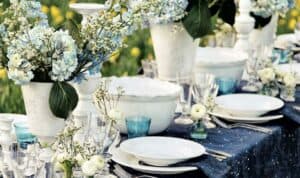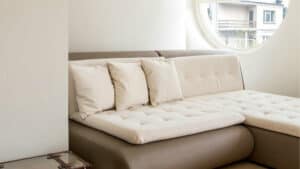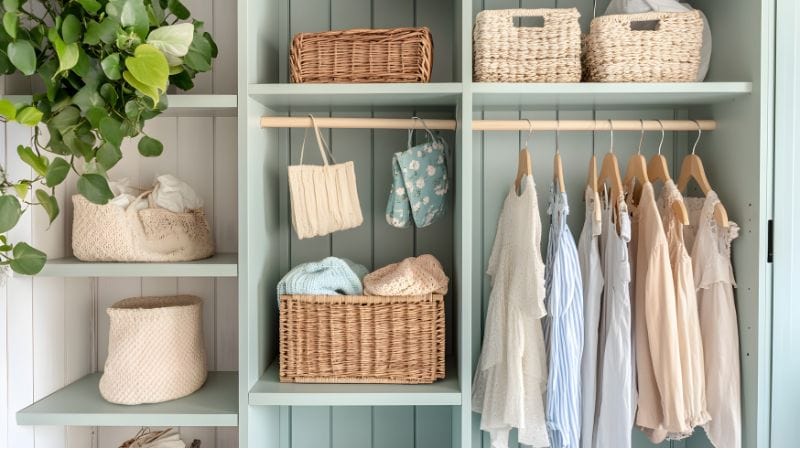
As you look for the ideal place to store your clothes, two classic pieces of furniture often come to mind: the wardrobe and the armoire. At first glance, they might seem very similar. Both are tall, freestanding cabinets designed for storage. You might even hear people use the names interchangeably.
However, these two furniture pieces have different histories and are designed with slightly different purposes in mind. Knowing the difference between an armoire and a wardrobe can help you make the best choice for your home. It ensures you get a piece that is not only beautiful but also perfectly functional for your specific storage needs.
In this guide ,we will explore what each piece is, compare them side-by-side, and help you decide which one is the right fit for your space.
What is a Wardrobe?
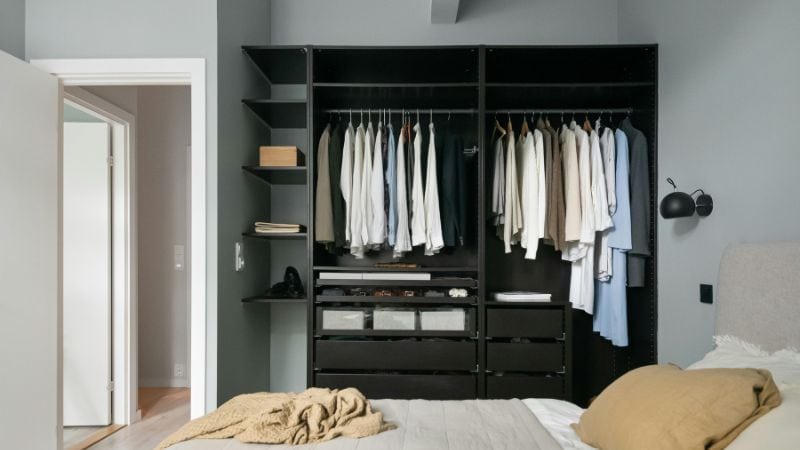
Let’s start with the wardrobe. The word “wardrobe” comes from old French words meaning “to guard” and “garments.” Essentially, it’s a guardian for your clothes! Traditionally, a wardrobe is a tall cabinet used primarily for storing hanging clothes, like dresses, suits, and coats.
A classic wardrobe is designed with a simple focus. Its main feature is a large, open space inside with a hanging rod for clothes on hangers. Below this hanging space, you might find a shelf or a drawer for folded items like sweaters or pants. Some wardrobes also have a small shelf or compartment up top, perfect for storing hats or luggage.
Key Features of a Wardrobe:
- Primary Use: Storing hanging clothing.
- Typical Interior: Dominated by a hanging rod; may have one or two shelves or drawers.
- Doors: Usually features two full-length doors that open outward.
- Look: Often simpler in design, focused on function over fancy details.
Wardrobes are the go-to solution for bedroom storage, especially in homes that don’t have a built-in closet. They are all about keeping your clothes neat, organized, and free from wrinkles.
What is an Armoire?
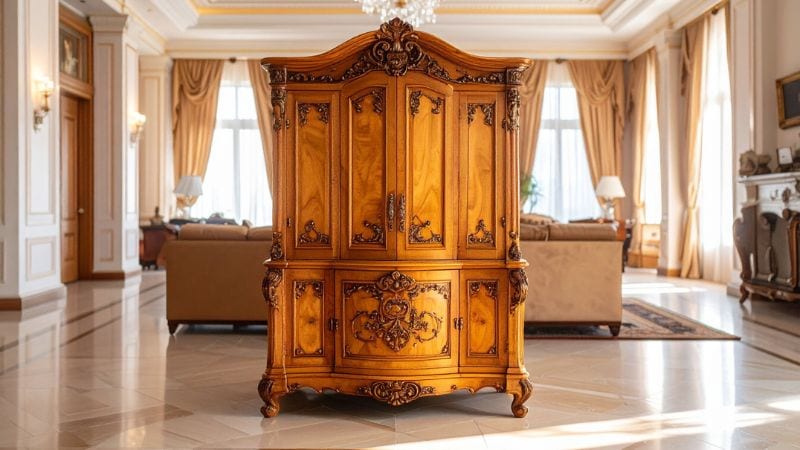
Now, let’s talk about the armoire. This piece has a grander history. The name “armoire” comes from the French word “armoire,” which itself comes from the Latin word for “closet for storing arms.” Yes, originally, armoires were used to store weapons and armor in medieval times!
As needs changed, so did the armoire. It evolved from holding weapons to holding other valuable items. In France, it became famous for storing fine china and linens. Today, an armoire is a more versatile storage piece. While it can hold clothes, it’s often designed for more.
You’ll often see armoires used as media centers to hide televisions and electronics, as pantries in dining rooms, or as elegant linen closets. Because of its history, an armoire often has a more decorative and imposing look than a standard wardrobe.
Key Features of an Armoire:
- Primary Use: Versatile storage—for clothes, media, linens, or other items.
- Typical Interior: Often has more shelves, drawers, and compartments. It may have a short hanging space or none at all.
- Doors: Usually two large doors, but may also feature drawers on the lower part.
- Look: Tends to be more ornate, with decorative hardware, carvings, and a heavier, more substantial feel.
Think of an armoire as the more adaptable and often more decorative cousin of the wardrobe.
Side-by-Side Comparison: Armoire vs Wardrobe
To make it even clearer, let’s put them side-by-side and look at the key differences.
| Feature | Wardrobe | Armoire |
|---|---|---|
| Origin | Developed for storing garments. | Evolved from storing arms and armor. |
| Primary Function | Storing hanging clothes. | Versatile storage for clothes, media, linens, etc. |
| Interior Layout | Dominated by a full-length hanging rod. | More shelves, drawers, and compartments. |
| Size & Shape | Tall and rectangular. | Often larger, wider, and more substantial. |
| Design & Style | Simpler, more functional designs. | Often more ornate and decorative, with carvings and detailed hardware. |
| Best For | Bedrooms without closets; primary clothing storage. | Living rooms, dining rooms, or bedrooms needing versatile storage; hiding electronics. |
A Note on the Merger of Terms:
It’s important to remember that in modern furniture stores, the lines have blurred. Many companies will call any tall clothing cabinet a “wardrobe,” and the term “armoire” is sometimes used to make a piece sound fancier. This is why looking at the interior and the design is more important than just the name on the tag.
Which One Is Right for Your Home?
Choosing between an armoire and a wardrobe comes down to what you need to store and where you plan to put it. Here’s a simple guide to help you decide.
Choose a Wardrobe If…
- You need a closet substitute: If your bedroom lacks a built-in closet, a wardrobe is your best friend. It is specifically designed to keep your daily clothes organized and accessible.
- Your main need is hanging space: If you have a lot of dresses, suits, or coats that you need to hang to prevent wrinkling, the interior of a wardrobe is made for you.
- You prefer a simpler look: Wardrobes often have a cleaner, more minimalist style that can fit into modern bedrooms without overwhelming the space.
- Your space is limited: While still large, wardrobes are often a bit less bulky than many armoires, making them a good fit for standard-sized bedrooms.
Choose an Armoire If…
- You need versatile storage: If you need to store a mix of things—like folded sweaters, jeans, blankets, and electronic equipment—an armoire’s shelved interior is more practical.
- You want to hide a TV or create a home office: An armoire can be a beautiful way to conceal a television when it’s not in use. Some are even designed as “office armoires” with a pull-out desk and compartments for a computer.
- You want a statement piece: Because of their often decorative nature, an armoire can serve as a beautiful focal point in a room. Its detailed craftsmanship can add a touch of elegance and history.
- You have a larger room: Armoires tend to be bigger and heavier. They need a bit more space to look balanced and not crammed in.
Thinking About Your Space:
Before you buy either one, remember to measure! Measure the spot where you want the furniture to go, and don’t forget to measure your doorways and hallways to make sure you can get it into the room. Also, think about the style of your home. A very ornate, dark wood armoire might look out of place in a bright, modern studio apartment, just as a plain, white wardrobe might look too simple in a traditional, classic home.
Frequently Asked Questions
Can an armoire be used as a wardrobe?
Yes, absolutely. If the armoire has a hanging rod inside, it can work perfectly well as a wardrobe. In fact, many people use them this way. Just check the interior to make sure it has the features you need for your clothes.
What is a chifforobe?
This is a great question! A chifforobe is a hybrid piece that combines features of both a wardrobe and a chest of drawers. It typically has a section with a hanging rod on one side and a set of drawers on the other. It’s another excellent option for all-in-one clothing storage.
Are wardrobes and armoires outdated?
Not at all! While our storage needs have changed, the need for organized, freestanding storage has not. These pieces are timeless. They are essential in older homes without closets and are popular in modern homes for their charm and versatility. An armoire used to hide a TV and gaming consoles is a very modern solution.
Which is typically more expensive, an armoire or a wardrobe?
This depends more on the materials, brand, and craftsmanship than the type. However, because armoires often feature more decorative details and complex construction, they can sometimes be more expensive than a simple, functional wardrobe of a similar size.
Conclusion
In the end, both the wardrobe and the armoire are classic, useful pieces of furniture. When you are shopping, don’t get too caught up in the name. Open the doors. Look inside. Ask yourself, “What do I really need to store in here?” By focusing on the interior layout and the style that fits your home, you will find the perfect piece. Whether you choose the clothing-focused wardrobe or the adaptable armoire, you’ll be adding a beautiful and functional organizer to your space that will serve you well for years to come.


